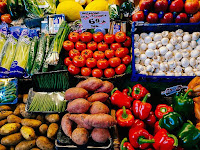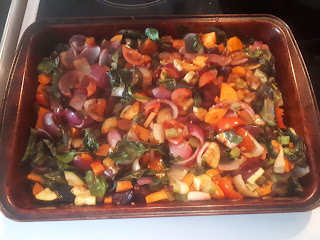One thing we are all told to do is eat our recommended portions of fruit and vegetables every day. In the UK, this is at least 5 portions. It seems like a small number however for many people it is not easy to achieve. I know, I was one of them.
Indeed, for about 20 years of my life, from roughly the age of 5 to 25, I never ate any fruit or vegetables. Nowadays I meet or surpass the recommended number of portions and find it quite easy as well.
So why do so many of us find it hard to consume fruit and vegetables? How did I come around from none to tonnes? Read on below!
Table of contents
- My story with fruit and vegetables
- What constitutes a portion?
- The best way to consume them?
- Summary
My story with fruit and vegetables
When I was quite young, around 3 to 5, I used to eat stew, which contained carrots etc. And fruit etc. however at some point in my elementary school days I forwent all fruit and vegetables. Why? Simple, they were not as nice and sweet and processed food and sweets. By my teens I was fond of stuffing my face with sweets and I remember trying an apple to which I revulsed at how bland it was.
My diet throughout my school years was atrocious and bad for my health. Only after leaving secondary school did I get into exercising and then into healthier eating. For my New Year's Resolution in 2003 I give up the sweets.
By about the age of 23-24, my girlfriend got me to try some grapes and clementines, which I found lovely and sweet. By giving up the sweets for a protracted period of time, my taste buds became de-sensitised to sweetness allowing me to enjoy the natural sweetness of fruit. Indeed having had some chocolate and sweets over the years since then, I find them far too sweet for my liking that they make me feel sick if I eat half a bar.
From that point on I started to get more and more into fruit and then vegetables until I had tried almost any I could get my hands on. I even got into eating raw vegetables such as carrots, turnips, olives and even onion! What helped was getting into fancier cooking such as with adding spices and sauces to give the more bland vegetables some flavour. The most recent vegetable I've finally gotten around to trying and adding to my diet is beetroot.
Finally after about two decades of depriving my body of essential nutrients and vitamins, its finally getting what it needs.
What constitutes a portion?
We all know that fruit and vegetables come in an amazing variety of shapes and sizes, and all with different content. Yet it is incredibly easy to figure out how much of a particular item equals a portion. 80 grams. Yep, 80 grams of any fruit or vegetable equals one portion.[1][2][3][4]
Of course there are guidelines on the visual quantity of a particular item that can be used as well if you don't fancy bringing out the scales. You can find a general list at this NHS article, or this PDF guide from the NHS that gives a specific breakdown by item.
So does this mean simply eat 400 grams (5 portions of 80 grams) of carrots or cabbage etc. to get your fill? Well, no. It is recommended that you get your portions from a wide variety of fruit and vegetables to maximise the intake of different vitamin and nutrient combinations.
The best way to consume them?
Obviously fresh and raw is the answer to this question as heating food can destroy nutrients and cold storage can degrade nutrient content. A contradiction to this is the increase in beta-carotene content in cooked vegetables such as carrots.[5] Similar has been reported for increased availability of lycopene in cooked tomatoes.[6]
Despite this, some vegetables in my experience are easier to consume cooked. So what way should you cook them? According to this piece of research it all depends on the vegetable, however the two recommended ways are steaming and microwaving with a small bit of water. This preserves more nutrients than frying or boiling, which cause the most loss and damage.
Whilst I steam certain foods, most of my vegetable intake is roasted in the oven with rapeseed oil, and sometimes the vegetables are still pretty firm when I've cooked them meaning more of their content is preserved. In the past I usually stir-fried it but this is not the best method. Yet if you prefer stir-fried, well it is still 100 times better than not eating any vegetables!
Using your own combination of favourite sauces and spices you can tailor it to your specific taste.
These vegetable roasts or stir-fries go great with any meat and staples such as chips, rice, and pasta. Any left overs can also be easily refrigerated and eaten at another time.
When it comes to fruits, an easy way to consume them is to mix several different kinds into a blender and make a juice out of them. You can even use yogurt and frozen fruit to make a good healthy smoothie.
Summary
We have all heard of the benefits of fruit and vegetables, from its anti-oxidant and anti-cancer properties to its vitamin and nutritional value. A portion is a lot smaller than one thinks at only 80g, and when a combination of vegetables are made as part of a stir-fry or roast, its easier to meet your recommended portions.
Whilst stir-frying and boiling are not the best way to cook vegetables, it is still better for you than not eating them at all. Indeed cooking them this way can, as it was for me, be a gateway towards healthier cooking methods.
Hopefully this has helped inspire you to get more of your recommended portions of fruit and vegetables. If you have any questions feel free to comment below or send me some feedback!
Lyle Richardson,
Gym Pal - Your friend in the world of fitness





0 comments:
Post a Comment